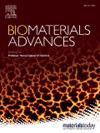一种具有神经再生和预防粘连双重功能的早期释放雷帕霉素神经包裹
IF 6
2区 医学
Q2 MATERIALS SCIENCE, BIOMATERIALS
Materials Science & Engineering C-Materials for Biological Applications
Pub Date : 2025-07-15
DOI:10.1016/j.bioadv.2025.214411
引用次数: 0
摘要
神经再生能力的限制和神经粘连的形成导致周围神经损伤(PNI)手术修复后预后较差。目前,还没有有效的治疗方法来改善手术修复后的功能恢复。雷帕霉素(Rapa)已被发现在PNI后的早期阶段通过清除细胞碎片促进神经再生。但其较低的口服生物利用度和明显的不良反应限制了其临床应用。在这项研究中,我们开发了一种基于生物相容性单甲氧基聚乙二醇-聚乳酸-羟基乙酸(mPEG-PLGA)的生物相容性神经膜,用于局部递送Rapa。Rapa-mPEG-PLGA神经膜表面粗糙,亲水性好,机械强度强。体外释放研究显示,在前8天内开始快速释放,随后约10天稳定释放。释放的Rapa仍具有诱导细胞自噬和促进细胞迁移的生物活性。在坐骨神经横断即刻修复大鼠模型中,Rapa-mPEG-PLGA神经包膜的植入显著促进了轴突再生和髓鞘形成。此外,神经包裹有效地防止了神经粘连的发生。术后4周和8周采用Rapa-mPEG-PLGA膜包裹可改善功能恢复。综上所述,加载Rapa的mPEG-PLGA神经包膜通过在损伤后早期释放Rapa促进神经再生,并作为物理屏障减少神经粘连。这种局部双作用策略在手术修复后的PNI治疗中具有很好的临床应用前景。本文章由计算机程序翻译,如有差异,请以英文原文为准。

An early rapamycin-releasing nerve wrap with dual function for nerve regeneration and adhesion prevention
Limited ability of nerve regeneration and the formation of nerve adhesions result to poor outcomes of peripheral nerve injury (PNI) following surgical nerve repair. Currently, there is no efficient therapy for the improvement of functional recovery after surgical repair. Rapamycin (Rapa) has been found useful for promoting nerve regeneration through removing cellular debris at the early stages after PNI. However, its lower oral bioavailability and significant adverse effects limit its clinical application. In this study, we developed a biocompatible nerve wrap based on biocompatible monomethoxy poly (ethylene glycol)-poly (lactic-co-glycolic acid) (mPEG-PLGA) for the local delivery of Rapa. The Rapa-mPEG-PLGA nerve wrap exhibited a rough surface and good hydrophilicity with strong mechanical strength. In vitro release studies revealed an initial rapid phase within the first 8 days, followed by a stable release about 10 days. The released Rapa remained its bioactivity to induce autophagy and promote cell migration. In a rat model of sciatic nerve transection and immediate repair, the implantation of Rapa-mPEG-PLGA nerve wrap significantly enhanced axonal regeneration and myelination. Furthermore, the nerve wraps effectively prevented the occurrence of nerve adhesions. Improved functional recovery was observed with Rapa-mPEG-PLGA membrane wrap post-surgery 4 weeks and 8 weeks. In summary, the Rapa-loaded mPEG-PLGA nerve wrap promoted nerve regeneration by releasing Rapa at the early stage after injury, and acted as a physical barrier to reduce nerve adhesions. This local dual-action strategy is a promising candidate for clinical translation in the treatment of PNI following surgical repair.
求助全文
通过发布文献求助,成功后即可免费获取论文全文。
去求助
来源期刊
CiteScore
17.80
自引率
0.00%
发文量
501
审稿时长
27 days
期刊介绍:
Biomaterials Advances, previously known as Materials Science and Engineering: C-Materials for Biological Applications (P-ISSN: 0928-4931, E-ISSN: 1873-0191). Includes topics at the interface of the biomedical sciences and materials engineering. These topics include:
• Bioinspired and biomimetic materials for medical applications
• Materials of biological origin for medical applications
• Materials for "active" medical applications
• Self-assembling and self-healing materials for medical applications
• "Smart" (i.e., stimulus-response) materials for medical applications
• Ceramic, metallic, polymeric, and composite materials for medical applications
• Materials for in vivo sensing
• Materials for in vivo imaging
• Materials for delivery of pharmacologic agents and vaccines
• Novel approaches for characterizing and modeling materials for medical applications
Manuscripts on biological topics without a materials science component, or manuscripts on materials science without biological applications, will not be considered for publication in Materials Science and Engineering C. New submissions are first assessed for language, scope and originality (plagiarism check) and can be desk rejected before review if they need English language improvements, are out of scope or present excessive duplication with published sources.
Biomaterials Advances sits within Elsevier''s biomaterials science portfolio alongside Biomaterials, Materials Today Bio and Biomaterials and Biosystems. As part of the broader Materials Today family, Biomaterials Advances offers authors rigorous peer review, rapid decisions, and high visibility. We look forward to receiving your submissions!

 求助内容:
求助内容: 应助结果提醒方式:
应助结果提醒方式:


